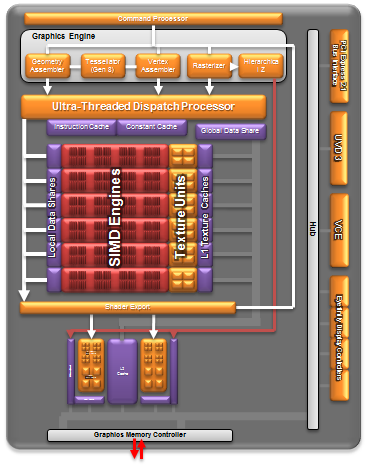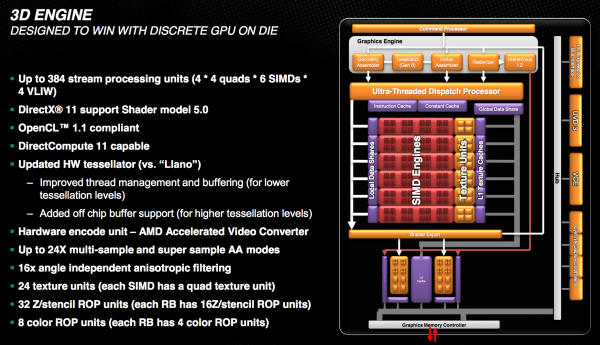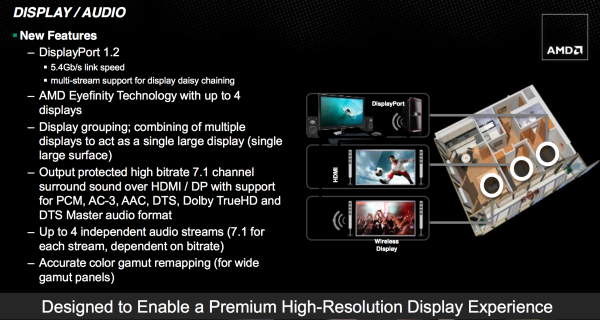The AMD Trinity Review (A10-4600M): A New Hope
by Jarred Walton on May 15, 2012 12:00 AM ESTImproved Turbo
Trinity features a much improved version of AMD's Turbo Core technology compared to Llano. First and foremost, both CPU and GPU turbo are now supported. In Llano only the CPU cores could turbo up if there was additional TDP headroom available, while the GPU cores ran no higher than their max specified frequency. In Trinity, if the CPU cores aren't using all of their allocated TDP but the GPU is under heavy load, it can exceed its typical max frequency to capitalize on the available TDP. The same obviously works in reverse.
Under the hood, the microcontroller that monitors all power consumption within the APU is much more capable. In Llano, the Turbo Core microcontroller looked at activity on the CPU/GPU and performed a static allocation of power based on this data. In Trinity, AMD implemented a physics based thermal calculation model using fast transforms. The model takes power and translates it into a dynamic temperature calculation. Power is still estimated based on workload, which AMD claims has less than a 1% error rate, but the new model gets accurate temperatures from those estimations. The thermal model delivers accuracy at or below 2C, in real time. Having more accurate thermal data allows the turbo microcontroller to respond quicker, which should allow for frequencies to scale up and down more effectively.
At the end of the day this should improve performance, although it's difficult to compare directly to Llano since so much has changed between the two APUs. Just as with Llano, AMD specifies nominal and max turbo frequencies for the Trinity CPU/GPU.
A Beefy Set of Interconnects
The holy grail for AMD (and Intel for that matter) is a single piece of silicon with CPU and GPU style cores that coexist harmoniously, each doing what they do best. We're not quite there yet, but in pursuit of that goal it's important to have tons of bandwidth available on chip.
Trinity still features two 64-bit DDR3 memory controllers with support for up to DDR3-1866 speeds. The controllers add support for 1.25V memory. Notebook bound Trinities (Socket FS1r2 and Socket FP2) support up to 32GB of memory, while the desktop variants (Socket FM2) can handle up to 64GB.
Hyper Transport is gone as an external interconnect, leaving only PCIe for off-chip IO. The Fusion Control Link is a 128-bit (each direction) interface giving off-chip IO devices access to system memory. Trinity also features a 256-bit (in each direction, per memory channel) Radeon Memory Bus (RMB) direct access to the DRAM controllers. The excessive width of this bus likely implies that it's also used for CPU/GPU communication as well.
IOMMU v2 is also supported by Trinity, giving supported discrete GPUs (e.g. Tahiti) access to the CPU's virtual memory. In Llano, you used to take data from disk, copy it to memory, then copy it from the CPU's address space to pinned memory that's accessible by the GPU, then the GPU gets it and brings it into its frame buffer. By having access to the CPU's virtual address space now the data goes from disk, to memory, then directly to the GPU's memory—you skip that intermediate mem to mem copy. Eventually we'll get to the point where there's truly one unified address space, but steps like these are what will get us there.
The Trinity GPU
Trinity's GPU is probably the most well understood part of the chip, seeing as how its basically a cut down Cayman from AMD's Northern Islands family. The VLIW4 design features 6 SIMD engines, each with 16 VLIW4 arrays, for a total of up to 384 cores. The A10 SKUs get 384 cores while the lower end A8 and A6 parts get 256 and 192, respectively. FP64 is supported but at 1/16 the FP32 rate.

As AMD never released any low-end Northern Islands VLIW4 parts, Trinity's GPU is a bit unique. It technically has fewer cores than Llano's GPU, but as we saw with AMD's transition from VLIW5 to VLIW4, the loss didn't really impact performance but rather drove up efficiency. Remember that most of the time that 5th unit in AMD's VLIW5 architectures went unused.
The design features 24 texture units and 8 ROPs, in line with what you'd expect from what's effectively 1/4 of a Cayman/Radeon HD 6970. Clock speeds are obviously lower than a full blown Cayman, but not by a ton. Trinity's GPU runs at a normal maximum of 497MHz and can turbo up as high as 686MHz.
Trinity includes AMD's HD Media Accelerator, which includes accelerated video decode (UVD3) and encode components (VCE). Trinity borrows Graphics Core Next's Video Codec Engine (VCE) and is actually functional in the hardware/software we have here today. Don't get too excited though; the VCE enabled software we have today won't take advantage of the identical hardware in discrete GCN GPUs. AMD tells us this is purely a matter of having the resources to prioritize Trinity first, and that discrete GPU VCE support is coming.















271 Comments
View All Comments
medi01 - Friday, May 18, 2012 - link
Somehow one doesn't wonder at tomsharware, that comparing chips with vastly different price is a bad idea.TC2 - Sunday, May 20, 2012 - link
amd cpu is far behind intel cpu! about gpu! nvidia is also far better as performance & software support! so for professionals and buyers with budget there isn't point to go with amd! :)))but for amd - as good as is get :))) sorry
kevmanw430 - Tuesday, May 22, 2012 - link
Jarred, what version of Skyrim was tested? Bit of a question in a forum discussion, would like to know.Thanks!
JarredWalton - Wednesday, May 23, 2012 - link
Running the Steam variant, so it's automatically updated. At time of testing, I believe it was version 1.4 (with high res texture pack). The tested sequence is in the area of Whiterun, as I found in initial playing (on a desktop) that it was one of the more demanding areas. I wanted to find the "worst case" situation for playing the game, so that if you get >30 FPS in our benchmark, you'll generally get >30 FPS throughout the game. There's a reasonable chance that other parts of the game are less CPU intensive and thus might show Trinity in a better light, though it's debatable whether that's more or less meaningful than the current results.seapeople - Tuesday, May 22, 2012 - link
Why do you even read computer reviews then? Every single review I've ever read in my life on any site ever created includes a new, top of the line product in the graph REGARDLESS of what's being reviewed. It's not bias, it's not inattentiveness, it's not even remotely absurd as you state, it's quite simply expected for computer reviews.seapeople - Tuesday, May 22, 2012 - link
This is quite silly. We're not comparing a $90,000 Mercedes to a $16,000 Hyundai, we're comparing a processor that might be in an $800 computer to one that might be in a $600 computer based on how sales are at any particular point in time.It's amazing that two or three negative posters account for roughly 50% of the comments on this thread. Somebody is trying too hard.
Stradi - Friday, May 25, 2012 - link
I'm a bit confused about how this review was done. Are they comparing the APU without the extra discrete GPU against intel Ivy Bridge with discrete GPU from nVIDIA and saying the Ivy Bridge is better for gaming? or is this comparing the APU with AMD's discrete GPU that's on crossfire against intel/nVIDIA setup?I assumed the crossfire setup will actually prevail against ivy bridge/nvidia in terms of gaming. I was waiting for Trinity not because it's got a decent GPU in there, but it gives you the option to crossfire with AMD's discrete GPU. And while I like the nVIDIA's discrete GPU option, I didn't think it can havest the intel HD 4000 graphics power and add to it.
I need some clarification on this. I hope they didn't mean to compare an AMD's new APU with Intel's latest+nVIDIA's latest. Why would any reviewer think that'd represent a fair comparison? why would they put an extra discrete GPU in one machine and say that's a better gaming machine?
rarson - Tuesday, May 29, 2012 - link
The AMD APU is not paired with a discrete APU.Obviously the review is confusing and full of incongruous comparisons, but Jarred and Anandtech aren't going to fix it.
rarson - Tuesday, May 29, 2012 - link
Anandtech now responds to criticism by simply deleting it. Or was that Jarred's doing?R3MF - Friday, June 1, 2012 - link
the slides say OpenCL 1.1, will full support in hardware for 1.2 arrive?